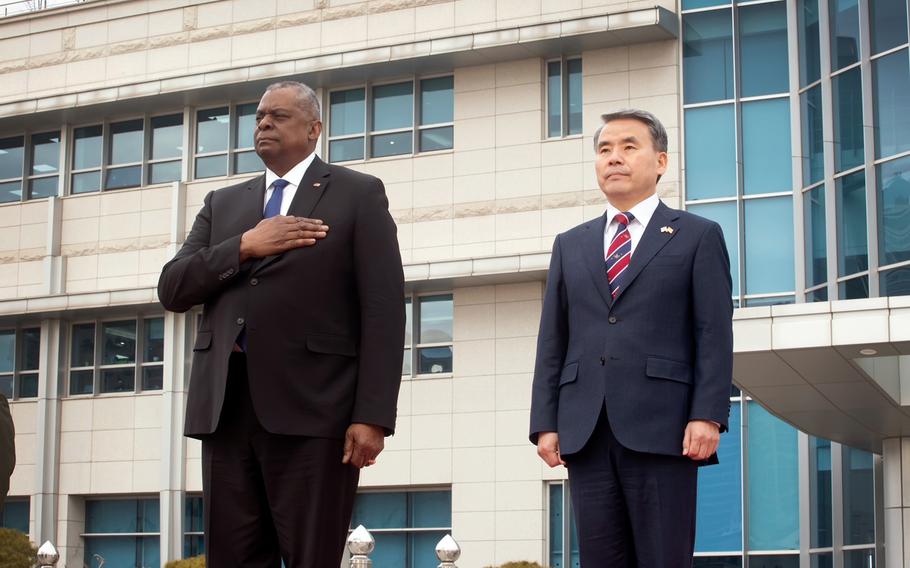
Secretary of Defense Lloyd Austin, left, and his South Korean counterpart, Lee Jong-sup, stand during the U.S. national anthem at the ministry’s headquarters in Seoul, South Korea, Tuesday, Jan. 31, 2023. (South Korea’s Ministry of National Defense)
CAMP HUMPHREYS, South Korea — The U.S. military presence in South Korea will be more visible in the near future due to North Korea’s continued threat to regional security, U.S. Defense Secretary Lloyd Austin said Tuesday on his third trip to South Korea.
Austin, speaking to reporters in Seoul with his South Korean counterpart, Minister of National Defense Lee Jong-sup, reaffirmed the United States’ commitment to South Korea’s defense.
The focus of Austin’s trip, which will include a stop in the Philippines, is to strengthen the military relationship with U.S. allies and to address the “sharp uptick in destabilizing Chinese operational behavior” in the region, according to a Pentagon news release Sunday.
Austin said talks with Lee earlier Tuesday were “highly productive” and he expressed his “unwavering commitment to maintaining peace on the Korean Peninsula.”
“Our ultimate goal is peace and not conflict,” Austin told reporters. “And toward that end, our countries have worked side by side to deter large-scale conflict, to strengthen our combined capabilities and to defend the rules-based international order that keeps us all secure.”
Due to North Korea’s “unprecedented number of provocations,” Austin plans more military exercises in South Korea similar to the aircraft carrier USS Ronald Reagan's visit to Busan in September and air-power exercises involving B-52 Stratofortress bombers and F-22 Raptors in December, he said.
“You can look for more of that kind of activity going forward,” Austin said. “But in addition to that, you can look to see deeper consultation between our two countries and leadership.”
The U.S. and South Korean militaries have scheduled a tabletop exercise in February that will include a scenario based on North Korea’s nuclear threat, according to a news release Thursday from the Ministry of National Defense.
North Korea fired roughly 75 missiles last year in 36 separate days of testing, including a ballistic missile that flew over northern Japan and prompted residents to seek shelter. The communist regime last fired a short-range ballistic missile on Jan. 1.
Lee said his country and the U.S. will continue to strengthen their extended deterrence, a policy that refers to the range of military options with Washington and its allies against an adversary.
To that end, Austin said South Korea has at its disposal the “full range of U.S. defense capabilities including our conventional, nuclear and missile defense capabilities.”
In addition to 28,500 troops deployed in South Korea, U.S. military assets in the country include a Terminal High Altitude Area Defense, or THAAD, anti-missile system deployed there since 2017.